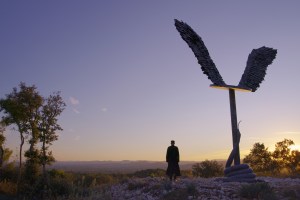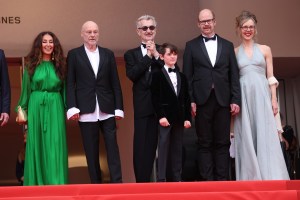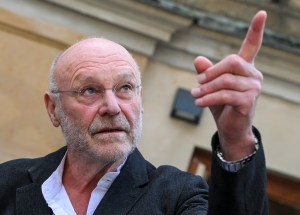The Oscar-contending documentary Anselm marks an encounter between two of the world’s great artists – one renowned for cinema, the other for painting, installations, and sculpture.
The filmmaker, Wim Wenders, began his career more than 50 years ago, with credits that include Paris, Texas, Wings of Desire, Buena Vista Social Club, The Salt of the Earth, and Pina, and two this year alone – Anselm and the narrative feature Perfect Days. His protagonist in Anselm – the German-born artist Anselm Kiefer, may not be as well known among the public as Wenders, but his work stuns in its power, erudition, and scale. Simply put, Kiefer makes art of monumental dimensions.
Anselm Kiefer in ‘Anselm’
Janus Films
“We were in the landscape of his own studio [outside Paris],” Wenders tells Deadline, “this huge depot, bigger than airplane hangars — and several of them.”
Capturing the size of the workspace and the individual artworks, Wenders concluded, called for something different than a standard 2D approach.
“To take people there and to see so much, 3D is the best way. It not only enables you to see the space and be there spatially, but it also enables you to see more,” Wenders explains. “It is a very intense medium in order to grasp and see the aura of something. Your mind is working in overtime when you watch 3D because it’s your mind that puts together the space.”

‘Anselm’
Janus Films
He adds, “3D has a beautiful quality that is almost untapped because people know 3D only in the shape of action movies, and then there’s a cut every two seconds or five… 3D done physiologically correct so that you can really look at it calmly and it doesn’t hurt your eyes and it’s the right depth, it is as if you were there. And that quality of 3D, that poetic, immersive quality, they don’t even know yet.”
Kiefer’s work is held in the permanent collection of leading museums like the Art Institute of Chicago and the Museum of Modern Art in New York, and has been exhibited at the Guggenheim Museum Bilbao in Spain and the Centre Pompidou in Paris, among many other venues. The Gagosian Gallery, which represents Kiefer, describes his sculpture and canvases as “encompassing a broad range of cultural, literary, and philosophical allusions—from the Old and New Testaments, Kabbalah mysticism, Norse mythology and Wagner’s Ring Cycle to the poetry of Ingeborg Bachmann and Paul Celan.”
Wenders marvels of Kiefer, “He’s not afraid of anything. I think he does think that everything can be painted, you name it. Whatever you will tell him, he says, I can paint it.”

‘Anselm’
Janus Films
In addition to Croissy, Wenders shot in Barjac in the south of France where Kiefer maintained a studio space in a disused silk factory the size of about 25 football fields. Those were not the only filming locations.
“Also the landscape in the remote forest of the Odenwald [in Germany], where Anselm worked for 10 years [early in his career] without ever anybody coming to see him. No art historians, no gallerists, no museum people,” Wenders notes. “He laid the foundation of his entire work there as a completely unknown painter. So, we were there as well. We shot majestic winter landscapes. We were near the Rhine where he grew up as a little boy, which heavily influenced his entire life and his work, the post-war landscape in Germany.”

CANNES, FRANCE – MAY 17: (L-R) Manuela Lucá-Dazio, Anselm Kiefer, Wim Wenders, Anton Wenders, Daniel Kiefer and Donata Wenders attend the Cannes Film Festival.
Gisela Schober/Getty Images
Wenders weaves brief dramatizations into the film, segments that feature the filmmaker’s grandnephew, Anton Wenders, as a young Anselm, and Kiefer’s own son, Daniel Kiefer, portraying his father in his 30s. The younger Kiefer was a bit reluctant to take on the acting assignment.
“I told him, ‘Come on, Daniel. Now you’re going to have to play this because I don’t know anybody else who could do it so truthfully.’ And he said, ‘Oh, I can’t do that. I’m not an actor.’ I said, ‘Your father’s not an actor either. He’s in the movie,’” Wenders says.
The director continues, “Daniel said, ‘But then I have to call [my dad] and ask him permission.’ And I said, ‘No, you’re not going to call him and tell him, because your father only had one condition that he asked me — If you make this film, then don’t show me a treatment. Don’t show me anything. Don’t tell me what you’re doing. You can do whatever you want, but just promise me you will surprise me in the end.’ And I promised that. And then I said to his son, ‘If you tell him you’re going to play him when he was a 35-year-old man, you’re going to spoil my surprise. So you are not going to call him because he would not want you to call. He would want to be surprised by it.’ So, we surprised Anselm, among other things, by the appearance of his own son as his younger self.”
Among the most startling scenes in the film are ones that show the artist roughing up his work, so to speak — like setting fire to his paintings.

Anselm Kiefer
ens Kalaene/picture alliance via Getty Images
“He would shove his paintings into an oven and bake them, because he likes to see time eating them up,” Wenders explains. “Some of them have been out in the open, subjected to rain and frost and snow, whatever, for years, and then he brings them back inside and continues work on them. He likes time to be incorporated.”
Wenders has written that “privacy is sacred… A man’s life should remain his own private domain.” So Anselm isn’t intended to be a biopic.
“I really felt his work should speak for him and the work should speak for itself,” Wenders says. “I didn’t want to make a film in any way about giving an opinion of his work. I wanted the work to stand out. And you can experience it in the film, you can make a judgment of what you saw and what you felt and what was in front of you… And I felt that was so much more true to who he was.”
Wenders adds, “And it was so much more true to seeing art. If you go to a museum and you’re in front of something that impresses you, you don’t want to have the explanation in front of you. You’re not seeing the explanation; you’re seeing the work. And so I felt this was a more biography of Anselm’s work and of his imagination than the biography of the man.”

